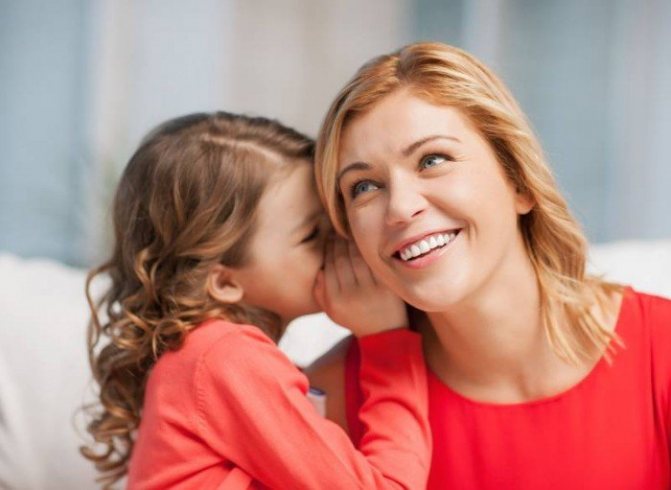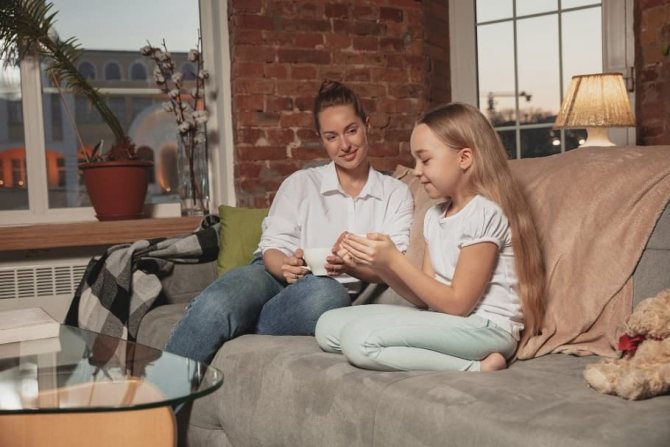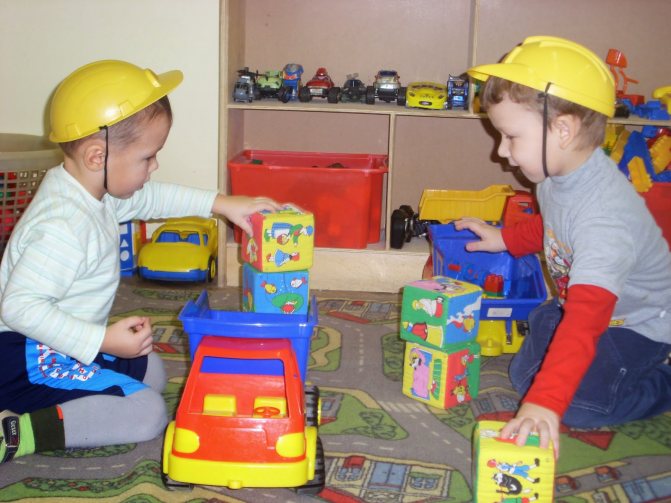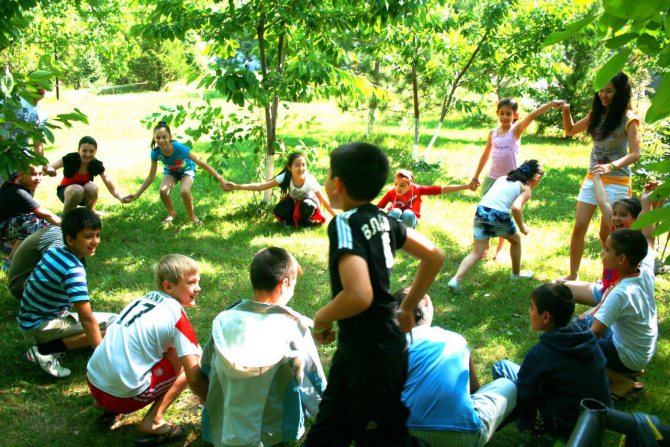A child is a small part of our society. He lives and develops among people, which means that he needs to communicate with others. A sociable person always feels confident in the company of people, regardless of their social status. It’s always interesting and comfortable to be with such a person; as a rule, they are the “soul” of any company. In order to achieve such results, a child, during his preschool childhood, goes through certain forms of communication.
Communication with peers is an important component of socialization
Why does a child need contact with peers?
As the baby grows up, he needs to communicate with other children of the same age or a little older.
This communication is significantly different from that which is accepted within the family circle. After four years, a child will be much more interested in talking with his peers than with his parents or relatives. When playing with children, the baby will be able to fully realize his fantasies and will be able to behave at ease and freely. And this behavior significantly affects speech. By contacting peers, the child will be able to clearly express his emotions. When communicating with parents, the baby behaves calmly, even passively. And when he begins to interact with other children, he may suddenly laugh, express his feelings with facial expressions, bright intonation, or even squeal. When communicating with peers, a child uses up to 10 facial and speech manifestations, while in a conversation with an adult partner - only half. It is those feelings that are expressed in contact with children that help the child acquire relaxedness, freedom and ease between peers.
Communication between teacher and children
The professional activity of a teacher without pedagogical communication is impossible. Communication between a teacher and children is a system of interaction with the aim of providing educational influence, as well as the formation of a child’s self-esteem and appropriate relationships, and the creation of a favorable microclimate for mental development. The teacher should strive to make pedagogical communication with children as effective as possible, which will contribute to the mental development of children. To achieve this, the teacher should know what his pupils expect from communication, and also take into account the changing needs throughout childhood.
The teacher’s communication with children prepares for the emergence of newer, more complex types of activities. The content and form of the teacher's pedagogical communication are determined by specific tasks that are solved in the process of directing the activities of children.
The effectiveness of pedagogical communication largely depends on the teacher’s ability to take into account the age and individual characteristics of children. The teacher chooses forms of influence to communicate with children of different temperaments and ages. The teacher often expresses special warmth towards the little ones, and also uses affectionate forms of address that children are accustomed to hearing in the family. The teacher expresses interest and sensitivity in his work with older children. However, in this case, for the optimal nature of the relationship, it is necessary to be able to joke and, if necessary, speak strictly and seriously.
The content of the teacher’s communication changes taking into account the children’s behavior, and their inclinations, interests, gender, and characteristics of the family microenvironment are also taken into account. In the process of interacting with children, the teacher uses both indirect and direct influences.
Direct influences include influences that are directly addressed to the student, and also relate to his behavior or relationships (showing, explaining, indicating, reproaching, approving). Indirect influences include influences through other persons. Indirect influences that are effective in working with children are the effects of playful communication.
How do preschoolers communicate with others?
If we briefly consider how forms of communication progress in preschool age, then it is best to turn to the work of the famous psychologist M.I. Lisina, who identified four levels of communication from infancy to 7 years, designating them as a form:
- Situational-personal
- Situational business
- Extra-situational-cognitive
- Extra-situational-personal
The first ones in this list are formed earlier, based on specific actions, objects, and experiences. By older preschool age, they do not disappear, but partially give way to more developed forms that are not tied to the situation. These changes are facilitated by the development of children's speech and verbal-logical thinking.
The highest form of communication for preschool age is one that promotes understanding of the meaning of human relationships, as well as the assimilation of the norms and values of society. Consequently, this is an extra-situational-personal form of communication.
Communication with children 7-12 years old
What happens next, after 7 years and up to 12?
These skills are being improved. The main role here is played by communication with peers during study. The teacher and how learning is structured now play a huge role. By the way, this is not just about school. Trainer and training, teacher at a music or art school...
Any training is very important now. And it has a serious impact not only on the development of the child as an individual, but also affects his ability to communicate and is transferred to communication in the family. Yes, we must admit that now the family is forced to take into account to a large extent the influence of the environment on the child.
What points are especially important at this age, what should we pay attention to:
how to attract the attention of your interlocutor, how to address another person; show the need to understand the position of the interlocutor; teach techniques for seeking agreement and making decisions.
At this age, the child reconsiders his attitude towards communication. If before this, at the age of 5-7, he was happy to communicate with someone who was simply often nearby, with whom he regularly spent time together, now he already chooses according to a different principle. Now, at 8-12 years old, the most important partners for him are those who help him, respond to requests and share interests.
Therefore, it is possible to involve a child in communication with a baby at this age if the baby is at least partially included in the interests of the elder.
Topic 1.1. Communication and its role in the development of a preschool child
Plan:
1. The concept of communication in psychology. Types of communication and its basic properties.
2. Essence, functions and levels of communication.
3. Verbal and nonverbal communication in the mental development of a child.
4. The role of communication in the development of skills of communicative behavior, cognitive sphere and personal qualities of the child.
1. The life of every normal person is literally riddled with contacts with other people. The need for communication is one of the most important human needs. Relationships with loved ones give rise to the most acute and intense experiences and fill our actions and actions with meaning. A person’s most difficult experiences are associated with loneliness, rejection, or misunderstanding by other people. And the most joyful and bright feelings - love, recognition, understanding - are born from closeness and connection with others.
Communication is the main condition and the main way of human life. Only in communication and in relationships with other people can a person feel and understand himself, find his place in the world.
Communication is always directed at the other person. This other person does not act as a physical body or organism, but as a subject, as a person who is endowed with his own activity and his relationship to others. Orientation to the activity of another and to his attitude is the main uniqueness of communication. It follows that communication
- this is always mutual, reciprocal activity, implying the opposite direction of the partners.
Any act, even if it has all the external signs of interaction (speech, facial expressions, gestures), cannot be considered communication if its subject is a body deprived of the ability to perceive or respond to mental activity. And only an orientation towards the attitude of another and his activity, taking into account his actions can indicate that this act is communication.
In order to determine whether a particular type of interaction is communication, one can rely on the following four criteria proposed by M. I. Lisina.
First criterion:
communication presupposes
attention and interest in another
, without which any interaction is impossible. Looking into the eyes, paying attention to the words and actions of another indicate that the subject perceives the other person, that it is directed at him.
Communication -
This is not just an indifferent perception of another person, it is always
an emotional attitude towards him
.
The emotional coloring of the perception of the partner’s influences is the second criterion
of communication.
The third criterion
Communication are
proactive acts
aimed at attracting the attention of a partner to oneself. Since communication is a reciprocal process, a person must be sure that his partner perceives it and relates to its effects. The desire to arouse the interest of another, to attract attention to oneself is the most characteristic moment of communication.
The fourth criterion
communication is
a person’s sensitivity
to the
attitude
that his partner shows towards him. A change in one’s activity (mood, words, actions) under the influence of a partner’s attitude clearly indicates such sensitivity.
Taken together, the listed criteria may indicate that this interaction is communication. However, communication is not just attention to another or an expression of attitude towards him. It always has its content
, which connects. The very word “communication” speaks of community and involvement. Such a community is always formed around some content or subject of communication. This could be a joint activity aimed at achieving a result, or a topic of conversation, or an exchange of opinions about an event, or simply a reciprocal smile. The main thing is that this subject of communication, this content, be common to the people who entered into communication.
Many difficulties in raising children are connected precisely with the fact that the content of communication between a child and an adult does not coincide: the adult talks about one thing, and the child perceives something else and, accordingly, talks about his own. And although outwardly such a conversation may be very similar to communication, it does not create commonality, but, on the contrary, alienation and misunderstanding. Here you cannot blame the child for lack of understanding or disobedience. The teacher’s task is precisely to create this community, that is, to understand the child and involve him in the content about which communication takes place. But for this you need to know your little partner well, and not limit yourself to demands and comments.
The role of communication is especially important in childhood. For a small child, his communication with other people is not only a source of various experiences, but also the main condition for the formation of his personality, his human development.
Life sometimes arranges cruel experiments, depriving young children of necessary communication with loved ones when, for one reason or another, they are deprived of parental care. The consequences of such cases are tragic: at the age of three to five, children do not have the simplest self-care skills, do not speak, do not walk, and show amazing passivity. But even when children are not completely deprived of communication, but do not have the proper completeness and quality, the consequences are very sad - the children are significantly behind in mental development.
It has long been noted that children growing up in orphanages, as a rule, lag behind in mental development from their peers living in families. Why does this happen? After all, it would seem that medical care, nutrition and physical care in closed children's institutions are no worse than in ordinary kindergartens.
Sometimes it seems to us, adults, that the mental development of a child occurs as if by itself: children grow, become stronger, smarter, and the role of adults comes down to creating the necessary conditions for child development: ensuring safety, feeding, clothing, warming. But that's not true.
The surrounding adults are not only a condition that helps children live and grow normally, but also the main source, the engine of mental development. A child cannot become a normal person if he does not master the abilities, knowledge, skills, and relationships that exist in human society. By itself, a child will never learn to speak, use objects, think, feel, reason, no matter how well he is dressed and fed. He can master all this only together with other people and only through communication with them.
Numerous psychological studies show that communication between a child and an adult is the main and decisive condition for the development of all mental abilities and qualities of the child: thinking, speech, self-esteem, emotional sphere, imagination. The level of future abilities of the child, his character, and his future depend on the quantity and quality of communication.
The child’s personality, his interests, self-understanding, his consciousness and self-awareness can only arise in relationships with adults. Without the love, attention and understanding of close adults, a child cannot become a full-fledged person. It is clear that he can receive such attention and understanding, first of all, in the family. But, unfortunately, children often experience a lack of necessary communication both in the family and in kindergarten. Quite often, a child does not have satisfactory emotional connections with his parents, or he lacks positive emotional contacts with peers, or the teacher does not like him. Such inferior, deformed communication, of course, negatively affects the formation of the child’s personality and his mental development. In order for adults, who are responsible for the fate and development of children, to prevent the harmful consequences of a lack of communication in a timely manner, it is necessary to have a good understanding of what communication is and what role it plays in different periods of childhood.
Observing how people communicate with each other, we can see only the external, superficial picture of their interaction - who says what, who looks how, etc. Meanwhile, behind this external picture there is always an internal, invisible, but very important layer of communication - interpersonal relationships, that is, what motivates one person to reach out to another. Behind every statement or action addressed to another person there is a special attitude, a special need for communication. The same action or statement can have a completely different basis and meet different needs. For example, a child asks an adult a question: “Who runs faster, the wolf or the hare?” What prompts a child to ask this question? It is impossible to answer without knowing this child and the specific situation. There can be a variety of motives behind this simple appeal. Maybe the child is really interested in which animal runs faster, maybe he wants to attract the attention of an adult, or maybe it’s important for him to demonstrate his knowledge in front of his friends. Or: one child complains about another’s bad behavior. How should a teacher approach this? Again, this question cannot be answered unambiguously until we find out what is behind the complaint and what need prompts the child to turn to the teacher. Maybe this is the need to talk to an adult and attract his attention, or maybe the need to establish that he is right (“I know how to behave correctly!”), or maybe the child wants his friend to be punished, and he looked good compared to him.
If the teacher does not know, understand, feel the inner need that prompts the child to enter into communication, he will not be able to understand him, and therefore, answer him correctly. And in order to correctly answer a child and understand him, you need to know well not only his individual characteristics, but also the general patterns of development of communication in childhood.
At the same time, the need for communication and the nature of the relationship also depend on the communication partner, on the person with whom the child communicates. In preschool age there are two spheres of communication - with adults and with peers.
.
The question often arises: who does a child need more and with whom should children spend more time - with adults or with peers? In answering this question, it is important to emphasize that there cannot be an “either/or” opposition here. Both adults and peers are necessary for the normal development of a child’s personality. But their role in the lives of children is, of course, different. Communication with an adult and with a peer also develops differently.
Topic: The role of an adult in the development of communication between preschoolers and peers
For children to fully communicate and to establish humane relationships between them, the mere presence of other children and toys is not enough. The experience of visiting a kindergarten or nursery in itself does not provide a significant increase in the social development of the child. Thus, it was found that children from an orphanage, who have unlimited opportunities to communicate with each other, but are brought up in conditions of a lack of communication with adults, have poor, primitive and monotonous contacts with peers. These children are not capable of empathy, mutual assistance, or independent organization of meaningful communication. For these important abilities to emerge, proper, purposeful organization of children's communication is necessary, which can be carried out by a kindergarten teacher.
However, what kind of influence should an adult have in order for children’s interaction to be successful? There are two possible ways here: firstly, organizing joint subject-related activities for children; secondly, the formation of their subjective interaction. Psychological research shows that for younger preschoolers, object-based interaction is ineffective. Children focus on their toys and engage in mostly individual play. Their proactive approaches to each other come down to attempts to take away attractive objects from the other. They either refuse requests or appeals from their peers or do not respond at all. The interest in toys characteristic of children of this age prevents the child from seeing a peer. The toy seems to cover up the human qualities of another child.
The second way is much more effective, in which an adult establishes relationships between children, draws their attention to each other’s subjective qualities: demonstrates the merits of a peer, affectionately calls him by name, praises his play partner, and offers to repeat his actions. With this behavior of an adult, the children’s interest in each other increases, emotionally charged actions addressed to peers appear, and emotional and practical communication arises, the main features of which are described above.
Thus, the transition of children to subjective, communicative interaction itself becomes possible to a decisive extent thanks to an adult. It is the adult who helps the child discover his peer and see in him the same being as himself.
One of the most effective forms of subjective interaction between children in a kindergarten is joint games in which children act simultaneously and in the same way. The absence of a competitive element in such games, the commonality of actions and emotional experiences create a special atmosphere of unity and closeness with peers, which has a beneficial effect on the development of communication and interpersonal relationships.
Organized joint play of children can contribute not only to the development of their meaningful communication, but also to the adaptation of preschoolers to kindergarten. It is generally accepted that in order for a child to successfully get used to attending kindergarten every day, it is better to give him as much freedom as possible, thereby bringing the living conditions in the group closer to those at home. Therefore, when preparing to receive children, all the efforts of teachers are focused mainly on creating a cozy interior and selecting attractive toys. Great hopes are placed on the fact that toys will delight children, and that the teacher will help keep them occupied and organized.
However, very often, instead of joy, toys bring children great grief and even tears. Children take them away from each other, fight over an attractive doll or car. Here, persuasion and explanations that the toys are common, that they must be used together or in turn, yielding to each other, help little. The weak effectiveness of such advice is explained by the fact that they come into clear conflict with children’s usual experience of playing at home, where they are the absolute owners of toys and can play with them as much and as they wish. The lack of experience in gaming communication and playing together with peers leads to the fact that the child sees in another child mainly a contender for an attractive toy, and not a kind and desirable partner.
That is why, from the first days of visiting kindergarten, playing together is invaluable for children’s cheerful mood and their good attitude towards each other. The following chapters describe games that are simple and accessible even to younger preschoolers and have earned popularity among many generations of children. It is possible and necessary to conduct such games from the first days of children’s arrival in the group. They will help the teacher bring children closer together, unite them in a common activity that is interesting for everyone. Regularly holding such joint games will not only enrich children with new impressions, but also give them new social experience, which is so important for the development of their personality.
Communication: essence of the concept and types
Definition 1 Communication is the process of establishing and subsequently developing contacts between people, generated by their need for joint activities and including the exchange of information, mutual perception, and attempts to influence each other.
Note 1
Without communication, no human activity is possible.
Communication has content that is revealed in two interrelated aspects:
- Communication acts as a process that does not imply influencing changes in the psychological state of the partner. In this case, communication is used to establish and subsequently develop contacts between people. Moreover, this contact is based on joint activities or human needs.
- Communication acts as a process aimed at changing the psychological state of the partner. In this case, communication is used to change the behavior of the interlocutor, his personal and semantic formations.
The following types of communication are distinguished, depending on its means:
Finished works on a similar topic
- Course work: Psychological and pedagogical features of organizing communication among preschool children 470 rub.
- Abstract Psychological and pedagogical features of organizing communication among preschool children 230 rub.
- Test work Psychological and pedagogical features of organizing communication among preschool children 230 rub.
Receive completed work or specialist advice on your educational project Find out the cost
- Verbal communication is communication carried out through speech, providing a person with extensive communicative capabilities.
- Nonverbal communication is communication carried out through gestures, facial expressions and pantomimes, as well as through bodily or sensory contacts.
Basic conditions for the development of communication in preschool age
Close people play a primary role in a child’s life, and the child’s involvement in communication depends on them. Unlike older children, any activity of preschoolers is directed by adults. The corresponding features of communication between preschool children are emerging:
- An adult gradually immerses the child in the knowledge and skills developed by many generations of humanity, and without which life is unthinkable.
- The child perceives adults as a model - how to behave, what feelings and qualities to show in various situations.
- When communicating with adults, the preschooler receives feedback in the form of support and praise.
- Communication with peers provides an opportunity for a child to get to know himself and realize that he is one of the same children.
Motives for communication among preschoolers
Let's find out what motives drive preschoolers when they initiate communication with an adult or peer. A 3-year-old child hands his dad parts of a construction set - this is already an invitation to interact. The 4-year-old “why” besieges his parents with questions about what and how. A 5-year-old preschooler sits his grandmother in a chair and declares that he will treat her. A 6-7 year old child declares that he will go play with Mishka, but he is not interested in playing with Vladik.
In any of these cases, a leading motive appears. In younger preschoolers, cognitive motives predominate. Children understand that adults can and know a lot, therefore, in addition to emotional attraction to adults, they are driven by cognitive interest.
In middle preschool age, children need play partners. They are attracted to story-based games that simulate everyday life.
And since the most efficient play partner is an adult, children love to involve the role of mothers, grandmothers and, less often, the male part of the family in playing the role. Let gaming activities take place, but business motives of communication predominate at this age.
Older preschoolers actively communicate with both adults and peers. They become selective in relation to their peers. They make friends with whom they are ready to play “mother-daughter”, football and any other game. But a category of children with whom they do not intend to communicate is also identified. And if you play in a team game, then on different teams. Personal motives come to the fore at this age stage.
6-year-old children also continue to approach adults with questions or a desire to hear evaluation and praise. Along with knowledge of the world, they are now often interested in issues of a moral nature. The motives for communication between preschool children and adults in such cases can also be attributed to personal ones.
Development of communication skills in preschool children
The communication need is special. It develops as a need to know oneself and other people. To satisfy this need, at least primary communication skills are important. What communication skills can we talk about at the age of 3-5 years?..
To guide your child in developing successful interactions, pay attention to how your child expresses himself when trying to communicate with similar kids. Communication among younger preschoolers is characterized by:
Attention to a peer as someone “like myself.” Emotional perception of interaction with a peer. The desire to show oneself to one’s peers: what I can do, how I do it. Sensitivity and receptivity to how your little communication partner treats you.
All of the above components are important. When observing a child, it is easy for adults to notice what is present in abundance and what manifestations are completely absent. For example, if a preschooler is just demonstrating his achievements, you need to intervene and suggest: “Let’s see how a girl/boy can do...”, “You showed off your excavator, and now your friend wants to demonstrate how his cars drive.”
If you instill a culture of interaction from early childhood, over time, younger preschoolers intuitively demonstrate such an important quality - paying attention to their communication partner. This is an opportunity to develop your child's communication skills.
Communication among older preschoolers is more multifaceted. After 5 years, children spend significant time with peers. They are connected by various activities that require communication.
This is a role-playing game, creativity, and productive activity. Interaction with others often takes the form of cooperation.
How successful the cooperation will be depends on each participant. In older preschool age, the development of communication skills is closely intertwined with the formation of moral qualities
Goodwill and attention to others, affability and friendliness, willingness to help each other and the ability to give in are qualities without which interpersonal relationships cannot be successful.
How does a child’s communication change throughout preschool age?
The need for communication is inherent in human nature. But this need has many nuances. At different age stages, communication performs its actual functions. The nature and motives of communication change even at such a short stage as preschool childhood.
Firstly, the circle of people with whom the child interacts is gradually expanding. First of all, these are adults who explain, help, and protect everything. But then the preschooler’s interest in communicating with children like himself becomes more active.
Secondly, the subject matter of communication changes. Communication based on practical actions is being replaced by mental communication. If a 3-4 year old child reaches out to his interlocutor to show what a beautiful dress a doll has or talk about a new car, then a five year old child can spend hours asking his “Why?”, simply walking next to his mother.
No improvised objects or toys are needed to ask where the sun sets, what the rainbow is made of, or why the chicken doesn’t fly. And all this interests children so much.
The progress of communication in preschool age continues further, introducing new motives for the need to communicate with adults or peers. Having bombarded their parents with questions about natural phenomena and learned something for themselves, children strive to share their knowledge with their peers. And adults are addressed with the next batch of questions - now about people’s relationships, professions, hobbies and other human subtleties.
Communication is the best opportunity to get to know the surrounding reality and yourself. This is one type of activity, which is why it is called a communicative activity. Preschoolers are involved in this activity. They are guided by different motives. Forms of communication in preschool age acquire an extra-situational character, since the development of cognitive processes and speech allows the child to reason abstractly, and not just about what he sees and hears at a particular moment.
Lack of independence
Naturally, a parent wishes only the best for his child and strives to protect him from a variety of troubles. But the children grow up, and adults never stop caring for them. A bad grade at school - the parent is in a hurry to negotiate with the teacher about retaking the homework, but does it for the child.
Of course, the influence of adults is important for children, but no less important is the ability to solve their problems independently. A parent should be a support, not a blank wall between the child and the world around him
Unadapted, relying on adults for everything, and unsure of their abilities, children only multiply these negative aspects as they grow up. Lack of independence leads to the child growing up infantile.
How to understand that a child has communication problems
It may seem that everything is fine with the student: normal grades, teachers do not complain about behavior, classmates do not offend. And at the same time, the child is unhappy. Perhaps it's because he can't make friends. Here are a few signs that make it easy to understand:
- the child is reluctant to go to school and returns from there sad;
- does not mention classmates in conversations;
- refuses to call or write to the guys if he needs to know his homework;
- no one invites the child to visit, and he himself does not invite anyone.
How to prevent psychological problems: raising children
To prevent the occurrence of psychological problems in children, it is necessary to talk with the child about everything that worries him, and constantly offer his help and protection. The sooner a problem is identified, the easier it is to solve it and prevent the development of a serious complex.
You should carefully observe how the child communicates with his peers. His communication and behavior can tell a lot about the presence of a problem and its nature. For example, if a child does his best to earn the favor of his peers, this indicates a lack of love, warmth and attention to him.

In addition, you should always remember that each child is individual, has his own character traits, emotional traits that should be taken into account in the process of education. You need to respect him, love him for who he is, with all his shortcomings and advantages.
Psychology of communication with a child and positive aspects
If all of a child's mistakes are highlighted while their strengths and victories are ignored, a tense atmosphere is created. The child will think that he is doing everything wrong, that he is a loser and is only upsetting his parents.
If you only tell a child what not to do - “don’t talk to adults like that”, “don’t do that”, “don’t say that”, he will rebel because he doesn’t understand how to do it “that way”. Adults have formed patterns, this is how it should be, this should not be done. At first the child does not have them, later he will have to stretch his cocoon of stereotypes in order to live in society
It is necessary to replace these phrases with incentives to action, and focusing on praiseworthy behavior. The child will switch gears and know what he needs to do to earn praise
And parents will receive an independent, psychologically mature child, with the right approach to life.
Take care of your children, they are the most precious thing we have!
Igor Fomichev, clinical psychologist,
expert at the Center for Special Research and Expertise.
Some features of personal communication
The desire to communicate with adults largely depends on the personal expectations of the preschooler. If a child has a predominantly positive experience of previous contacts with specific adults, he is drawn to them. Conversely, negative impressions cancel out the desire to communicate. Some grandmothers wonder why their grandchildren are so reluctant to visit them. They don’t even notice how zealously they protect the inviolability of their shelves, how strictly they reprimand the child when he violates the usual order in their apartment.
Personally, a preschooler needs warm emotional connections and adults to be interested in him, his activities and skills. The child expects support and empathy, he is sensitive to praise. This does not mean that children should be praised. But there will always be achievements worth celebrating.
It is curious, but the following phenomenon is observed: loving parents and grandparents always find a reason to support and praise the child. If there are no warm feelings, the child is often scolded and his mistakes pointed out rather than supported.
Children are attracted to the positive emotional content of relationships with significant adults. This is the favorable background against which cognitive and personal communication is successfully implemented.
Features of nonverbal communication
The peculiarities of communication between people without words are the use of gestures, postures, facial expressions, etc. instead of the language system. Such communication is considered the most capacious and reliable.
When communicating, a person listens not only to verbal information, but also looks into the eyes of the interlocutor, perceives his timbre of voice, rate of speech, intonation, facial expressions and gestures. Words can convey logical information, and non-verbal communication tools can complement this information and fill it with emotions.
Features of nonverbal communication are communication without words, which quite often occurs unconsciously. Non-verbal communicative interaction can complement and strengthen verbal communication or, conversely, contradict and weaken it.
Nonverbal communication is considered an older and more fundamental form of communication. The ancestors of Homo sapiens interacted with each other through gestures and facial expressions, breathing rate, body position, gaze, etc.
Nonverbal language can be universal (for example, babies laugh the same way) and vary depending on culture and nationality. Traditionally, nonverbal communication occurs spontaneously.
Words can perfectly convey the logical component of information, but verbal tools convey the emotional content of speech much better.
The peculiarities of human communication using non-verbal means are that such communication is quite difficult to control and manage, even by professional actors. Therefore, nonverbal communication is much more reliable, informative and reliable than verbal communication.
A person can learn to control some of the characteristic features of nonverbal communication. However, he will never be able to learn to control absolutely all characteristics. After all, an individual can simultaneously hold no more than 7 factors in his head. Therefore, the main feature of nonverbal communicative interaction is considered to be that it is spontaneous and unintentional. Nature gave tools for non-verbal interaction to humans. All gestures, facial expressions, body positions, etc. were developed in the process of evolution and natural selection over many millennia in order to come to this day as they are.
Mastering the language of nonverbal communication allows you to obtain a more effective and economical way of transmitting information.
Many gestures may not be recorded by the human consciousness, but will still fully convey the mood, emotions and thoughts of the interlocutor.
Technologies
They have become so integral to our lives, especially in the entertainment sector. A modern person spends a lot of time on the phone or computer, watching funny videos on the Internet and communicating via instant messengers. Children are no exception. Often, a modern child spends time playing video games from an early age. Their dynamism and special effects capture his imagination; the information shown on the screen is easy to digest.
Problems begin when the child comes to school. Educational and fiction literature does not carry the same brightness that a computer monitor has, and studying is much more difficult than completing levels in your favorite game. Because of this, children quickly become bored with activities, and the interest that appeared at first due to a change in environment quickly fades away.
The habit of relying on high technology relaxes children and reduces their motivation to learn new things. After all, when a child can get any information by pressing a few keys, he stops appreciating it.
Why is it necessary to communicate with different speech partners?
By communicating with peers, the child makes his vocabulary richer, his speech becomes more coherent and detailed, he is understood not only by peers, but also by adults. This happens because, unlike communication with dad or mom, a peer will not guess what is being discussed when the baby wants something or is dissatisfied with something. Unlike children, adults are always on the alert and very carefully monitor the gestures or facial expressions of their baby. But a peer will not do this. And in this case, the child will have to adapt to the new way of communication himself.

Communication with adults teaches the child new phrases and words. The baby learns to pronounce sentences and words correctly and learns the norms of communication. Although this knowledge is practically not useful to a child in everyday life. The application of this knowledge in practice involves the creation of certain life situations. Peers help the child find himself in an environment in which he can actively use everything he has learned from adult friends or relatives.
Therefore, in order for the speech of a child who will later go to school to develop fully, it is necessary to create precisely such conditions in which the child could communicate with active partners in speech contacts, that is, adults. From them he will receive a lot of new information and learn to speak correctly. And in parallel with peers who will help the child realize all his speech achievements received from his parents.
Why communication problems occur
The older generation often blames gadgets for this. In fact, children most often use smartphones and tablets just for communication: they discuss videos on TikTok, share content, and discuss on social networks.
And yet there are cases when a child prefers virtual communication because in reality it is difficult for him to find friends. This can happen for various reasons.
Reason 1. Shyness
Excessive timidity and indecisiveness do not allow the child to come up and talk to other children, take part in a game or answer at the board.
Solution: To meet people freely, you need to overcome shyness. For this, the child should not have problems with self-esteem. You can avoid them if you treat your child carefully, give him more independence, regularly notice his successes, and criticize only to the point and constructively.
Encourage your child’s desire to communicate and praise him for his courage. And never judge his personal qualities, only the act itself. The same information can be presented in different ways. Compare: “You didn’t say “thank you,” how rude, I’m ashamed of you!” or “Why didn’t you say “thank you”? Shy? There is no need to be shy, otherwise you might think that you are poorly brought up. But that’s not true, is it?” The second option will not harm the child’s self-esteem.
Reason 2: Family relationships
“Be silent when adults are talking!” - a child who constantly hears this will never learn to communicate.
Solution: Talk to your child on various topics, ask for his opinion, ask him to talk about what he saw on a walk or in a movie. A child who communicates a lot at home will find it easier to talk with peers. And if his participation in some conversation is undesirable, explain it gently: “We will definitely discuss everything with you later, but now we need to talk separately.”
If you maintain good relationships with others, invite friends to visit, and are caring and attentive to your loved ones, your child will develop the right ideas about how to communicate with other people. Excellent examples of friendship can be found in literature and cinema. Discuss the relationships of the characters and their actions - whether they acted correctly at one time or another, and what a child would do in their place.

Reason 3. Lack of communication skills
Other children avoid a child who does not know how to behave in society: he fights, takes things away, screams and does not listen to others.
Solution: This behavior is a reason to think about whether he is copying someone close to him or from TV. In any case, it is necessary to teach the child to communicate with peers. Tell us about the rules that must be followed so that other children want to be friends with him:
- do not offend others;
- do not take anything without permission and do not beg for it;
- if you want to join the game, ask, but if they refuse, don’t force yourself;
- share what you like;
- if you are entrusted with a secret, keep it;
- do not put yourself above others;
- consider other people's interests;
- if a friend is in trouble, help in any way you can;
- if a friend starts something bad, stop him;
- if you yourself did something bad, admit it and don’t do it again;
- take help and advice from other guys.
Empathy will help your child understand how others feel, and emotional intelligence will help you understand your own feelings. Help your child develop these qualities - they are indispensable for civilized communication.
Reason 4. Bad experience
The child tried to make new acquaintances, but encountered rudeness or, through negligence, behaved badly. Now he is offended, angry and refuses to communicate with other children.
Solution: The child must learn to solve such problems on his own, but at first he will need help. Discuss what happened in detail. Let him understand that resentment and anger will not help improve the situation. Explain who, where and why was wrong, and how to avoid repeating the situation.
Allowing a child to learn from his mistakes does not mean leaving him alone with the problem.
Reason 5. Inability to stand up for yourself
Often children are raised with the idea that they need to be obedient and kind to everyone. There are situations when this can turn against the child. For example, he cannot resist the aggression of other children and is led by their teasing. As a result, the child becomes disillusioned with communication and prefers loneliness.
Solution: The child must be prepared for the fact that not all children will treat him well. It will not be possible to protect your son or daughter from all troubles, but you can teach them how to react to them correctly.
Teach your child to say “no” in situations where his boundaries are violated or he is asked to participate in dubious activities. Explain that it is better to respond to name-calling with humor - this often discourages offenders. And never be the first to get into a fight, but defend yourself if there is no other choice.
Reason 6. Lack of social circle
None of the classmates share the child’s interests, or he himself is not interested in communicating with them.
Solution: Help your child find friends elsewhere. Visit child development centers, theater studios, sections and clubs - your child will get along better with children who love the same things as he does.
Keep games at home that you can play with a group and invite children to visit, meet their parents.
The main thing is to choose your social circle unobtrusively. If a child does not want to communicate with some boy or girl, he has the right to do so.
Features of communication with adults
During adolescence, with the development of thinking, with a broader knowledge of the world of social roles and the emergence of a sense of adulthood, the authority of their parents decreases in adolescents. Parents become “just people.” Therefore, they no longer submit to parental influence as easily as they did at a younger age.
The self-affirmation of a teenager and his demand for rights on an equal basis with adults create certain difficulties in relationships with parents. At the age of 11–12, the teenager’s struggle for autonomy begins, his liberation from control and guardianship. During this period, a peculiar consumer attitude towards parents and teachers is observed, due to the desire of adolescents to check the equality of their rights with adults. He protests against the preservation of “childish” forms of control, against the demands of obedience and expressed guardianship. A child demands respect and relationships on the same level as adults treat other adults. At the same time, the teenager still needs their help, protection and support.
A teenager not only strives to be considered an adult, but to be recognized as a person with an individuality
Hence the desire to attract attention to oneself by any means (sometimes this results in a demonstrative and ostentatious passion for what adults condemn). First of all, the more accessible aspects of adulthood are adopted: appearance and behavior (adult types of recreation, entertainment, cosmetics, various jewelry, vocabulary, etc.)
The assimilation of external signs affects a teenager’s self-awareness and makes him an adult in his own eyes, and, as it seems to him, in the eyes of others.
Disputes and differences in the views of teenagers with their parents do not concern all areas of life, but mainly everyday issues (clothing, hairstyle, presence at home in the evenings, etc.), studies and the ability to manage free time at their own discretion. By older ages, precedents for a “value” conflict appear: the teenager’s active defense of his own understanding of justice in various areas - from teacher comments and unfair grades to political and economic issues.
The emergence of conflicts signals parents about changes in the needs of adolescents. The frequency and severity of manifestations of problems in relationships with adults depends largely on the position of adults, on the style of family education, on the ability to implement respectful, but not condoning tactics in relation to the behavior of a teenager. The desire of parents to impose their opinions and society on teenagers, a skeptical attitude towards their interests, the tendency to “broadcast” and criticize rather than talk, etc. - causes a sharp protest in the teenager. Parents need to change the model of their relationship with their child, learn to combine closeness and independence, and weaken parental control without destroying warm, supportive child-parent relationships. During high school, teenagers expect parents to show interest and support, understanding and empathy, recognition and approval, trust and autonomy. Trusted communication “on an equal footing” with parents and other adults, the ability to negotiate and cooperate, becomes important.
The warmth of a supportive parent-child relationship allows the adolescent to explore different social roles and ideas, contributes to the development of his autonomy and the formation of positive self-esteem. A feeling of security and safety gives a teenager the opportunity to experiment, expanding the boundaries of his life and consciousness. On the contrary, if parents tend to impose, coerce or control the child, this interferes with the development of autonomy and leads to the formation of low self-esteem, depression and antisocial behavior.
During adolescence, it is extremely important for parents to treat their child correctly
Communication of preschoolers with adults and peers. Tutorial
1.2. Development of communication at an early age
A child is not born with a ready need for communication. In the first 2–3 weeks, he does not see or perceive an adult. But, despite this, his parents constantly talk to him, caress him, try to catch and hold his gaze. It is thanks to the love of close adults, which is expressed in these seemingly useless actions, that at the end of the first month of life, babies begin to see an adult, and then communicate with him.
The first form of communication between a child and an adult was called situational-personal.
At first, this communication looks like a response to the influence of an adult: the mother looks at the child, smiles, talks to him, and he also smiles in response, waving his arms and legs.
Then (at 3-4 months), at the sight of a familiar person, the child rejoices, begins to actively move, walk, attract the attention of an adult, and if the adult does not pay any attention to him or goes about his business, he cries loudly and resentfully. The most offensive thing for a baby who already has a need for communication is when adults don’t pay any attention to him, they simply don’t notice. They perceive even an adult’s dissatisfaction, his anger joyfully, because they show attention to the child, attention to him. The need for the attention of an adult -
this is the first and basic need for communication - remains with the child throughout his life. Later other needs join it, but in infancy it is the only one, and it is not so difficult to satisfy it. You just need to smile at the baby more often, talk to him, caress him.
Some parents consider all these influences unnecessary and even harmful. In an effort not to spoil the child, not to accustom him to excessive attention, they dryly and formally perform their parental duties: they feed by the hour, change the diaper, take walks, without expressing any parental feelings. This kind of strict, formal upbringing in infancy carries with it certain risks. The fact is that in positive emotional contacts with an adult, not only the child’s already existing need for attention and goodwill is satisfied, but also the foundation is laid for the future development of the child’s personality, his active, active attitude towards the environment, interest in objects, the ability to see, hear, perceive the world, self-confidence, etc. The prerequisites for all these important qualities appear in the simplest and most primitive, at first glance, communication between mother and baby. If in the 1st year of life a child, for some reason, does not receive sufficient attention and warmth from close adults (separation from the mother, parents being busy or their inability to play with the baby, etc.), this makes itself felt in one way or another further. Such children become constrained, passive, insecure or, on the contrary, cruel and aggressive. It can be very difficult to compensate for their unsatisfied need for the attention and kindness of adults at a later age. Therefore, teachers and psychologists need to show and explain to parents of young children how important simple attention and goodwill of close adults is for an infant.
The baby does not yet identify the individual qualities of an adult. He is completely indifferent to the level of his knowledge and skills, his social or property status, he does not care what he looks like or what he is wearing. The baby is attracted only by the personality of the adult and his attention and attitude towards him. Consequently, despite the primitiveness of such communication, it is motivated by personal motives,
when an adult acts not as a means for something (game, knowledge, self-affirmation), but as an integral and valuable personality.
As for the means of communication, at this stage they are exclusively expressive and facial in nature.
Outwardly, such communication looks like an exchange of glances and smiles: the screams and humming of a child, the affectionate conversation of an adult, from which the baby catches only what he needs - attention and goodwill.
So, the first in ontogenesis is the situational-personal form of communication, which remains the main and only one from 1 to 6 months of life.
During this period, the infant’s communication with an adult occurs outside of any other activity and itself constitutes the child’s leading activity. Situational and personal communication is characterized by the need for attention and goodwill, personal motives and expressive and facial means of communication.
However, already in the second half of the year, with the child’s normal development, the attention of an adult is no longer enough for him. The baby begins to be attracted to himself not so much by the adult himself, but by the objects associated with him. If you pick up a 10-11 month old child and try to establish emotional communication with him (smile, stroke, speak kind words, etc.), the baby will most likely begin to resist, grab and examine everything that comes to hand - an adult’s collar, his hair, glasses, watches, etc., and not at all respond to his smiles. The fact is that at this age a new form of communication between a child and an adult develops - situational business
and the associated
need for business cooperation.
The adult is now needed and interesting to the child not in himself, not for his attention and friendly attitude, but because he has different objects and knows how to do something with them.
The “business” qualities of an adult and, consequently, business motives for communication
come to the fore.
The means of communication at this stage are also significantly enriched. The child can already walk independently, manipulate objects, and take various poses. All this leads to the fact that objective-effective means of communication are added to expressive-facial ones -
children actively use gestures, poses, and expressive movements.
At first, children are drawn only to those objects and toys that adults show them. There may be many interesting toys in the room, but children will not pay attention to them and will be bored among this abundance. But as soon as an adult (or older child) takes one of them and shows how to play with it (how to move a car, how a dog jumps, how to brush a doll’s hair, etc.), children will be drawn to this particular toy, it will become the most necessary and interesting.
This happens for two reasons. Firstly, an adult remains for a child the center of his preferences, because of this he endows the objects he touches with attractiveness. These objects become necessary and preferred because they are in the hands of an adult. Secondly, the adult shows the children how to play with these toys. Toys themselves (like any objects in general) will never tell you how to play or use them. Only another, older person can show that rings need to be put on a pyramid, a doll can be fed and put to bed, and a tower can be built from cubes. Without such a demonstration, the child simply does not know what to do with these objects, and therefore does not reach out to them. In order for children to start playing with toys, an adult must first show and tell them what they can do with them and how to play. Moreover, when demonstrating certain actions with objects, it is important not just to perform them, but to constantly turn to the child, talk to him, look into his eyes, support and encourage his correct independent actions. Such joint games with objects represent business communication or cooperation between a child and an adult. The need for cooperation is fundamental for situational business communication.
The situational-business form remains the main one in a child’s communication with an adult throughout the entire early age (up to three years). It is characterized by the need for cooperation, business motives and objectively effective means of communication. The significance of this form of communication for the mental development of a child is enormous. It is as follows:
1) the child masters objective actions, learns to use household items (spoon, comb, potty), play with toys, dress, wash, etc.;
2) there is an intensive development of all cognitive processes (perception, attention, visual-effective thinking, memory);
3) the child’s activity and independence begin to manifest - by manipulating with objects, he for the first time feels independent from the adult and free in his actions; he becomes the subject of his activities and an independent communication partner;
4) the child’s first words appear: in order to ask an adult for the desired object, the child needs to name it, that is, pronounce the word, and this task - to say this or that word - is set before the child only by the adult.
Note that the child himself will never begin to speak without the encouragement and support of an adult. In situational business communication, an adult constantly sets a speech task for the child - showing the child a new object, he invites him to name this object, that is, to pronounce a new word after it. Thus, in interaction with an adult regarding objects, the main specifically human means of communication, thinking and self-regulation—speech—emerges and develops.
Communication between parents and children
The use of ridicule and nicknames towards preschoolers is unacceptable. Remarks such as “you crybaby”, “you’re just a dumbass”, “you’re not a man” will only alienate the child and make him lose confidence in himself. After such an attitude, the kids get offended and defend themselves with the following words: “what is he like?”, “well, let him be a cudgel,” “well, I’ll be like that!”
Sympathy for a preschooler should not be in words, but in deeds. There is no need to say such phrases as “calm down, this is such nonsense”, “if it grinds, there will be flour”, “don’t pay attention.”
Children with communication difficulties cannot tolerate tedious lectures such as “it’s time to remember that you should wash your hands before eating”, “always listen to your father”, “if you get distracted, you make mistakes.” After such notations, the child answers: “that’s enough,” “I know.” As a result, he develops psychological deafness.
Love your baby for who he is, always respect him, because he is the same person as you. Don't intrusively get into his soul. It’s better to listen carefully, try to understand what’s in his soul. It's hard to resist asking questions, but ask wisely.
Don't laugh off your child's problems. Avoid boring moralization: “you should do this,” “you need to respect your elders.” Such dreary phrases do not give anything new and their behavior does not change. The child feels guilt, pressure from authority, boredom, and often all together. Moral foundations, as well as moral behavior, are given not by words, but by the very atmosphere in the house, as well as the behavior of adults.
Don’t be straightforward in your advice: “I would fight back,” “go and apologize.” Often children do not listen to such advice. By advising something to your child, you are reminding him that he is small, inexperienced, and the authoritarian position of an adult only irritates him.
Features of communication between parents and children include the manifestation of trust. Don’t say: “it’s all because of you,” “I got into a fight again,” “I see right through you.” Frequent repetition of such phrases makes a preschooler furious.
Forms of communication with peers
Separation from an adult creates a new social development situation in which the child strives for independence and wants to actively act in the world of adults. The world of the people around you falls into two circles: close people and all other people. The child’s successes and failures, joys and sorrows depend on these relationships. Therefore, the social situation of development of this period is called “ child - social adult”
" Through relationships with adults, the child develops the ability to identify with people. The child learns accepted positive forms of communication that are appropriate in relationships with other people.
Communication with peers.
Adults remain a source of new information and assessment until the end of preschool age. However, during preschool age, other children take up more and more space in a child’s life. At 4-5 years old, a child already knows for sure that he needs other children and clearly prefers the company of his peers.
Features of communication with peers:
1. Variety of communicative actions.
When communicating with peers, a child is capable of not only arguing and demanding, but also deceiving and regretting. For the first time, coquetry, pretense, fantasy appear.
In relation to a peer, from 3 to 4 years old, the child solves the following tasks: managing the actions of a partner, control, evaluating actions, comparing with oneself.
2. Vivid emotional intensity.
Emotionality and relaxedness distinguishes communication with peers from communication with adults. Actions addressed to a peer are more affective. A preschooler is 3 times more likely to approve of a peer and 9 times more likely to conflict with him than with an adult.
From the age of 4, a peer becomes more attractive and a preferred partner.
3. Non-standard and unregulated communication.
If children adhere to certain rules of behavior when communicating with adults, then when communicating with peers they use the most unexpected actions:
they mimic, make faces, and compose fables
.
This freedom of communication allows the child to show his originality and individuality.
4. The predominance of proactive actions over reactive ones.
It is still difficult for a child to maintain and develop dialogue. For him, his own statements are more important than the speech of others. He supports an adult’s initiative 2 times more often than the proposals of another child.
In communication with peers, two turning points are observed at 4 years and 6 years:
At 4 years old, children clearly prefer the company of peers to adults and solitary play.
.
At the age of 6, selective affection begins to clearly manifest itself, friendship arises
.
Forms of communication with peers
1. Emotionally is a practical form of communication. (2-4 years)
The child expects his peers to participate in fun activities and craves self-expression. It is enough for him if a peer joins his game and intensifies the fun
At the same time, everyone strives to attract attention to themselves
2. Situational business form of communication (4-6 years)
This period was the heyday of the role-playing game. The plot-based role-playing game becomes collective. Outside the game: the guys agree on the distribution of roles, the conditions of the game)
3. Non-situational - business form of communication (6-7 years)
Half of the speech addresses to peers acquire an extra-situational character: that is, they talk about where they were, what they did, and evaluate the actions of a friend. “Pure communication” becomes possible, not bound by action or play. More and more contacts between children are observed at the level of real relationships, and less and less at the play level.
Along with the need for cooperation, the need for recognition and respect by peers is clearly highlighted.
The role of adults in shaping children’s communication with peers
The development of all forms of communication between children and peers is possible only under the direct guidance of an adult. The child must sequentially go through all its forms.
But it happens that a 4-year-old child does not know how to play with peers, and at 5 years old is not able to maintain a basic conversation.
Is it possible to catch up and teach a child to communicate with adults and peers?
There are special classes for this and they are proactive in nature. What does it mean? An adult provides a child with patterns of communication that the child is not yet familiar with. To do this, you need to learn to communicate well enough yourself. The main problem when organizing such classes is not just to demonstrate to the child a perfect, yet inaccessible form of communication - cognitive or personal, but the ability to lead the child, imperceptibly including him in the communication itself.

Story games - let them communicate
Based on the achieved level of communication, you can invite the child to play a game together, the number of participants should not exceed 5-7 children.
The peculiarity of the game is that an adult is assigned the role of both a leader and a participant: he must follow the rules of the game, evaluate the actions of preschoolers, and at the same time be, on an equal basis with other children, the same participant in the game. In the process of joint actions, children have the opportunity to focus on the player - the partner, and not be offended if they lose. Together with other children, they experience joy and feel their importance in playing together. When conducting such activities, shy or withdrawn children begin to feel at ease, free and easy. After playing together with adults, such children cease to feel fear in communication and freely turn to an adult with a request or question. Thus, the development of non-situational communication with peers and adults moves forward at a slow pace.

Children become more relaxed when playing together






